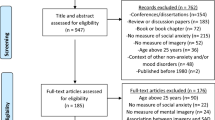Abstract
Previous research has shown that patients with social phobia often experience negative, observer-perspective self-images when in anxiety-provoking social situations [Hackmann, A., Clark, D. M., & McManus, F. (2000). Recurrent images and early memories in social phobia. Behaviour Research and Therapy, 38, 601–610]. The present experiment investigated whether negative images play a role in the maintenance of social anxiety. High and low socially anxious individuals (n = 40 in each group) were asked to give a speech in front of a camera. Half of the samples were instructed to hold in mind a negative, observer-perspective self-image during the speech, whereas the other half held a positive image of themselves. High socially anxious participants in the negative imagery condition perceived more bodily sensations, rated specific aspects of their performance unfavourably, and rated the self-image as a more accurate reflection of the self, compared to high socially anxious individuals in the positive imagery condition. For the low socially anxious individuals there was no significant difference between the two imagery conditions on measures of anxiety and performance. These results support the hypothesis that negative self-imagery may be involved in the maintenance of social anxiety.
Similar content being viewed by others
References
Beck, A. T., Steer, R. A., & Garbin, M. G. (1988). Psychometric properties of the BDI: Twenty-five years of evaluation. Clinical Psychology Review, 8, 77–100.
Beck, A. T., Steer, R. A., & Brown, G. K. (1996). Beck Depression Inventory Manual (2nd ed.). San Antonio, TX: Psychological Corporation.
Beidel, D. C., Turner, S. M., Stanley, M. A., & Dancu, C. V. (1989). The social phobia and anxiety inventory: Concurrent and external validity. Behavior Therapy, 20, 417–427.
Bryman, A., & Cramer, D. (1999). Quantitative Data Analysis, Routledge.
Chambless, D. L., Caputo, G. C., Bright, P., & Gallagher, R. (1984). Assessment of fear in agoraphobics: The body sensations questionnaire and the agoraphobic cognitions questionnaire. Journal of Consulting and Clinical Psychology, 52, 1090–1097.
Clark, D. M., & Wells, A. (1995). A cognitive model of social phobia. In R. Heimberg, M. Liebowitz, D. A. Hope, & F. R. Schneier (Eds.), Social phobia: Diagnosis, assessment and treatment. New York: Guilford Press.
Clark, D. M. (1999). Anxiety disorders: Why they persist and how to treat them. Behaviour Research and Therapy, 37, S5–S27.
Hackmann, A., Clark, D. M., & McManus, F. (2000). Recurrent images and early memories in social phobia. Behaviour Research and Therapy, 38, 601–610.
Hackmann, A., Surawy, C., & Clark, D. M. (1998). Seeing yourself through others’ eyes: A study of spontaneously occurring images in social phobia. Behavioural and Cognitive Psychotherapy, 26, 3–12.
Harvey, A. G., Clark, D. M., Ehlers, A., & Rapee, R. M. (2000). Social anxiety and self-impression: Cognitive preparation enhances the beneficial effects of video feedback following a stressful social task. Behaviour Research and Therapy, 38, 1183–1192.
Hirsch, C. R., Clark, D. M., Mathews, A., & Williams, R. (2003). Self-images play a causal role in social phobia. Behaviour Research and Therapy, 41, 909–921.
Kim, H. Y., Lundh, L.-G., & Harvey, A. (2002). The enhancement of video feedback by cognitive preparation in the treatment of social anxiety. A single-session experiment. Journal of Behavior Therapy and Experimental Psychiatry, 33, 19–37.
Mansell, W., & Clark, D. M. (1999). How do I appear to others? Social anxiety and processing of the observable self. Behaviour Research and Therapy, 37, 419–434.
Mellings, T. M. B., & Alden, L. E. (2000). Cognitive processes in social anxiety: The effects of self-focus, rumination and anticipatory processing. Behaviour Research and Therapy, 38, 243–257.
Rapee, R. M., & Heimberg, R. G. (1997). A cognitive-behavioral model of anxiety in social phobia. Behaviour Research and Therapy, 35, 741–756.
Salkovskis, P. M. (1991). The importance of behaviour in the maintenance of anxiety and panic: A cognitive account. Behavioural Psychotherapy, 19, 6–19.
Spielberger, C. D., Gorsuch, R. L., Lushene, R. E., Vagg, P. R., & Jacobs, G. A. (1983). Manual for the State-Trait Anxiety Inventory. Palo Alto, CA: Consulting Psychologists Press.
Spurr, J. M., & Stopa, L. (2003). The observer perspective: Effects on social anxiety and performance. Behaviour Research and Therapy, 41, 1009–1028.
Stopa, L., & Clark, D. M. (2000). Social phobia and interpretation of social events. Behaviour Research and Therapy, 38, 273–283.
Stopa, L., & Clark, D. M. (2001). Social phobia: Comments on the viability and validity of an analogue research strategy and British norms for the fear of negative evaluation questionnaire. Behavioural and Cognitive Psychotherapy, 29, 423–430.
Turner, S. M., Beidel, D. C., Dancu, C. V., & Stanley, M. A. (1989). An empirically derived inventory to measure social fears and anxiety: The Social phobia and anxiety inventory. Psychological Assessment, 1, 35–40.
Vassilopoulos, S. Ph. (2003). The value of video feedback in enhancing university students’ self-perception and expectation of performance. Scientia Pαedagogica Experimentalis, 40(2), 277–300.
Watson, D., & Friend, R. (1969). Measurement of social-evaluative anxiety. Journal of consulting and Clinical Psychology, 33, 448–457.
Wells, A., Clark, D. M., & Ahmad, S. (1998). How do I look with my minds eye: Perspective taking in social phobic imagery. Behaviour Research and Therapy, 36, 631–634.
Wells, A., & Papageorgiou, C. (1999). The observer perspective: Biased imagery in social phobia, agoraphobia, and blood/injury phobia. Behaviour Research and Therapy, 37, 653–658.
Woody, S. (1996). Effects of focus of attention on social phobics’ anxiety and social performance. Journal of Abnormal Psychology, 105, 61–69.
Author information
Authors and Affiliations
Corresponding author
Rights and permissions
About this article
Cite this article
Vassilopoulos, S. Social Anxiety and the Effects of Engaging in Mental Imagery1. Cogn Ther Res 29, 261–277 (2005). https://doi.org/10.1007/s10608-005-2993-4
Issue Date:
DOI: https://doi.org/10.1007/s10608-005-2993-4




